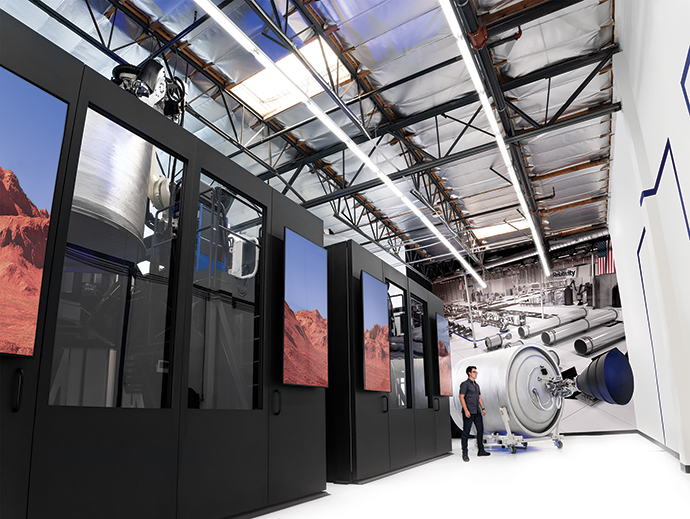Batesville, Mississippi, has turned out to be the ideal location for GE to build advanced aircraft engine components. The company produces components for the GE90 and GE9X aircraft engines — which power Boeing’s 777 and will eventually power the 777X. The facility is one part of a statewide aerospace cluster that includes Airbus Helicopter, Boeing, Lockheed Martin, Rolls Royce and dozens of others.
Mississippi is home to the Raspet Flight Research Laboratory at Mississippi State University. It’s the public sponsor of a Certificate of Authorization (COA) for flight testing of the Heron, a Stark Aerospace unmanned aerial system (UAS). Raspet often locates research staff on-site to support engineering and design and flight testing of large-scale UAS with companies, including MAV6. Also in the UAS space you’ll also find Aurora Flight Sciences and Stark Aerospace in Columbus and Northrop Grumman Unmanned Systems in Moss Point (Jackson County).
More into rocket science? Mississippi has lots of that, too.
In 2014, SpaceX launched its rocket-engine testing program at NASA’s Stennis Space Center in Hancock County. SpaceX announced in October 2013 it would bring initial testing of its Raptor methane rocket engines to the facility. The SpaceX Raptor engine development program represents the latest in propulsion technology and will produce the largest methane/LOX engines in U.S. history. Raptor engine components will be tested at the E-2 test stand at Stennis, which SpaceX upgraded with methane capability under an engine testing agreement.
3D Printed Rockets?
More recently, Relativity, the world’s first autonomous rocket factory and launch services company, announced in June 2019 an agreement with NASA and an incentive package from the Mississippi Development Authority to expand facilities and infrastructure at the Stennis Space Center. Relativity will leverage NASA infrastructure and capital investment incentives from the Mississippi Development Authority to build and integrate a pioneering robotic 3D printing rocket factory and an expanded testing facility for autonomous production of Relativity’s Terran 1 rocket launch vehicles. The agreement includes exclusive use of 220,000 square feet in building 9101 for a nine-year lease. The facility includes an 80-foot high bay, multiple bridge cranes, and extensive industrial infrastructure. The agreement also includes an option to extend the lease for an additional 10 years.
“We are excited to partner with NASA and the Mississippi Development Authority to bring our patented 3D printing rocket platform to Hancock County, “ says Jordan Noone, co-founder and CTO of Relativity. “We believe this groundbreaking technology is the future of aerospace manufacturing, and we look forward to bringing this innovation to the Gulf Coast.”
Relativity is developing the first and only aerospace platform to integrate machine learning, software, and robotics with metal 3D printing technology to build and launch rockets in days instead of years. Traditional aerospace manufacturing relies on fixed tooling, a complex supply chain, and extensive human labor. Relativity’s groundbreaking autonomous rocket platform is highly reconfigurable, with a radically simplified supply chain and no fixed tooling, reducing part count 100x.
“This partnership will foster innovation, investment, and growth in Mississippi,” says Tobias Duschl, VP of Operations at Relativity. “The integration of our 3D printing rocket production and testing facilities at one site will also enable Relativity to offer greater flexibility to commercial and government entities needing faster, more frequent, and lower cost access to space.”
The company will be building out first stage assembly, engine integration and testing, and a full 3D printing and robotics-enabled production line at the site. The technologies developed through Relativity’s Stennis Factory site are the first step toward the company’s long-term vision of 3D printing the first rocket made in Mars and expanding the human experience in space. Through the factory build-out and expansion, the company will create a total of 200 jobs and invest $59 million in Mississippi.
Relativity will invest in regional workforce development programs, university and education outreach, and community engagement initiatives. The infrastructure and resource incentives will enable the company to accelerate development and scaling of its technology and shorten lead times to launch.
“This agreement demonstrates again NASA’s commitment to work with our industry partners to expand commercial access to low-Earth orbit,” says Dr. Rick Gilbrech, Director, Stennis Space Center. “This helps NASA maintain focus on the ambitious Artemis program that will land the first female and the next male on the south pole of the moon by 2024. Relativity is a valuable member of the Stennis federal city and we look forward to building on our already successful partnership. This is a significant expansion of their presence at Stennis and we appreciate their confidence in making south Mississippi an integral part of their future.”
Relativity is on track to conduct its first orbital test launch at the end of 2020 and enter commercial service in 2021.

